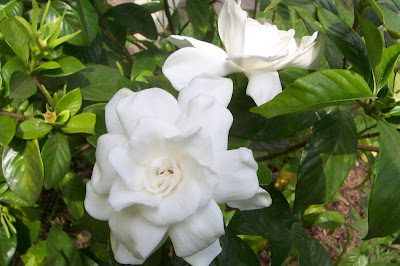Nothing looks better in a flower bed or garden in summer than lush, flourishing, tropicalesque foliage to blend in with your blooms and hide the naked legs of tall plants. In one of my beds, I have a tropical plant that has fit the bill for me over the last three years. My problem is that I have no idea what it is! Below is a picture showing off the leaves of this healthy beauty. A lady that I bought some daylilies from just pulled a piece of her plant off and gave it to me. I plopped it into the ground, watered, and it promptly took off.
I am quite familiar with elephant ears and this plant does not seem to be one of any type, though it could be related. It dies to the ground every winter, but faithfully comes back in the spring. It's growing among my lantanas, roses, plumbago, King's Mantle, and a sago palm. It really adds and fills in this area when a shot of green is really needed and helpful. Below is a picture from another angle showing it on the right side of a Ham and Eggs lantana.
If anyone out there can identify this plant, I would be extremely happy. Even the lady that gave it to me didn't know what it is. She just knew it thrived well in our area. Don't neglect to have a few foliage plants in your garden. They add so much to a garden.
Addendum: I've since definitely identified this tropical plant as an Alocasia cucullata, also called a "Buddha's Hand." It's related to elephant ears.





+08-10-09.jpg)




+06-14-10.jpg)







+06-14-10.jpg)

+06-14-10.jpg)





+06-08-10.jpg)

















+06-10-10.jpg)


+06-10-10.jpg)
+06-10-10.jpg)

